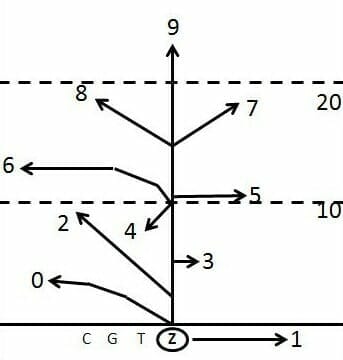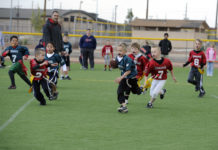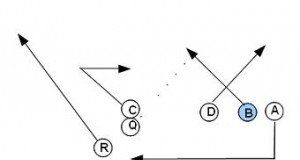
Youth Flag Football Passing tree
In football, Passing tree is a term used for any diagram through which we can know the various routes covered by the receiver. A football passing tree generally plays center on the routes covered by the receivers.
The passing route tree consists of a single straight line with several lines branching off it, reflecting the different possible routes of the receiver.
Also Read: Flag Football Positions
In football, the passing tree is a bit different from the conventional/usual one if you find them in the line. The tree also contains the different routes which we frequently run in.
The passing tree set up
The general setup of the football passing tree is such that the odd-numbered routes/branches run toward the sidelines. The even-numbered routes of the tree run in the middle of the field.
The tree also consists of two exception routes 5 and 9. The 5 and 9 number routes are just for hook and go routes respectively.
If you want someone to run a combo route, you’ll have to combine the two numbers.
Eg;
● A wheel route of the tree would be called a 19.
The wheel route is an out and then streak up the sideline route.
● A post-corner route will be called 87.
Reasons to use the passing tree with the youth flag football team
There may be a number of reasons to use the passing tree with your flag football team.
● One main reason is that it is much easier for play calling.
For example, it is much easier to call the 841 trips left instead of calling it Trips left, Post, Deep drag, Short out.
The easiest method to add the play/practice to your playbook maybe adding this with a simple number name(for example 14).
If you get any concerns and issues, it will be just a matter of calling team members from 14. Having the passing tree adds greater flexibility to your arsenal.
● The second reason to have the passing tree with your youth flag football team can be audibles. As being football players of just 9 years old, not everyone/the most of the quarterbacks is going to come into the line of the scrimmage, not everyone will read the defenses, not everyone will make a switch to play.
There will be times when you call a play, see the defense lined up in some different style, and you call a switch for a couple of routes after lining up the team on the ball.
One usual switch is calling out someone off a deep route to a slant or hook when the opposition defense lines up are expected to be deeper.
Another option to use the passing tree with your youth flag football team is to call a play with multiple routes for everyone but only one receiver.
You can also Inform the quarterback to call out a play for the receiver once it has come to the line scrimmage. This method is usually executed to bring the team into the thinking zone instead of just hearing and running to do it.
Eliminate Huddle or hurry up defense
Another great reason to use the passing tree with your youth flag football team is running a rapid and hurry up-defense with no-huddle. This can also be defined as the easiest route play-calling method mentioned above.
One benefit of using easier play calling is having a lined-up offense, calling out some routes, then continuing the play. Another benefit is that you can have a no-huddle defense with set-plays but this makes your options limited.
Being a coach, I personally call out a play using the passing tree. Once, all the players demanded wristbands on their hands. For that, I put 8 out of our plays in them and assigned them a numeric name. Each of the wristbands contained a visualized routes diagram that helped the offense to understand the play.
For a hurry-up offense, I would call 42. After the offense has lined-up, I can call ‘Hold’. This is a signal for the quarterbacks to wait for my “OK” signal and snap the ball.
There is also a tricky way to survey your team’s defense. You can simply call something like X-6, Z-4 which changes the routes of the X and Z receiver only.
As it is the winter season, it is necessary for me to add more plays on the wristbands however it will still contain the numeric name. The changes you should make is replacing the diagram with something like this; #31-Trips left-841. However, they are continuously practicing with the passing tree so the use of the wristbands will decrease gradually.
How to set-up the passing tree?
It is a bit difficult for the players to fully understand the diagram of the passing tree and integrate the structure into their thinking so that it becomes a habit and they do not have to work on it again and again.
Talking of myself, I started with just running 1s and 2s during practice.
During the warm-up passing drills, I kept the receiver’s line up close to the center.
Route 1: Ask the players to run a short out.
As the players completed the warm-up, every time before the snap I would call out 1 to start instilling the route name with the action.
Tip: While starting out a run, make sure that you run the receiver’s line on both sides of the field. Talking of ourselves, we started our warm-up with the receiver always on the left of the quarterback.
The 1s were out toward the left away from the quarterback and the 2s were toward the right of the quarterback.
It is good to add up 3-4 routes each practice so that the players can complete practice with all of them. The last step/sign to have your youth flag football team ready for a day game is to have a set method for calling out the different routes.
Playing a 5 on 5 matches, if I call Trips right- 157, my team knows that the receiver furthest to the left has to run the 1 route, the middle receiver runs the 5, and the far-right receiver has to run the 7 routes








